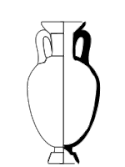Amforiskos
Amforiskos (stgr. αμφορισκος, pol. mała amfora) – rodzaj starożytnego greckiego naczynia ceramicznego na wonne olejki.
Charakterystyka
Amforiskosy były rodzajem małych amfor z krótką szyjką i dwoma uchwytami, używanym do przechowywania pachnących olejków (perfum). Odgrywały swoją rolę przy pielęgnacji i higiennie osobistej[1]. Informacji o ich zastosowaniu dostarczają głównie przedstawienia na stelach attyckich oraz malunki na naczyniach, z których jasno wynika, że były używane głównie przez kobiety, podobnie jak alabastron (w kosmetyce, olej po kąpieli)[2].
Formy
Amforiskos cypryjski, 1050–750 p.n.e. (Muzeum Narodowe w Warszawie)
Amforiskos attycki w formie migdała, ok. 400 p.n.e. (Metropolitan Museum of Art)
Zobacz też
Przypisy
- ↑ Amphoriskoi (ang.). getty.edu. [dostęp 2022-07-18].
- ↑ Charlotte Scheffer: Ceramics in Context: Proceedings of the Internordic Colloquium on Ancient Pottery, Held at Stockholm. sztokholm: Almqvist & Wiksell, 2001, s. 57. ISBN 978-91-2201-913-8. (ang.)
Media użyte na tej stronie
Autor: Sailko, Licencja: CC BY-SA 4.0
This is a photo of a monument which is part of cultural heritage of Italy. This monument participates in the contest Wiki Loves Monuments Italia 2016. See authorisations.
Autor: National Museum in Warsaw, Licencja: CC0
Amforiskos niesygnowany, Cypr, 1050-750 p.n.e., w zbiorach Muzeum Narodowego w Warszawie, kolekcja Censoli, 142403 MNW
Autor: National Museum in Warsaw, Licencja: CC0
Attycka amfora szyjowa czarnofigurowa (142328 MNW), malarz Diosfosa, 500- 475 p. Chr., Strona A: Peleus oddający Achillesa na wychowanie Chironowi, obok pies; strona B: Hermes z kaduceuszem, Maia i baran; postaciom towarzyszą inskrypcje. Warszawa
GIF Amphoriskos
Autor: unknown, Licencja: CC0
Autor: unknown, Licencja: CC0
Autor: unknown, Licencja: CC0















